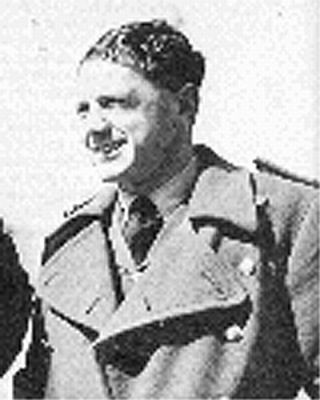Hull, Ceasar Barrand
- Date of birth:
- February 23rd, 1913 (Shangani, Rhodesia)
- Date of death:
- September 7th, 1940 (Purley/Surrey, Great Britain)
- Buried on:
- Commonwealth War Graves St. Andrew Churchyard
Plot: E. Row: 1. Grave: 477. - Service number:
- 37285, Royal Air Force
- Nationality:
- British
Biography
Caesar Hull was born in the town of Shangani, Southern Rhodesia, on 26 February 1914. The Hull family were farmers. In his early teens the family moved to Swaziland, and Caesar completed his schooling at St. Johns College in Johannesburg. He was a champion boxer, and in 1934 was a member of the South African Boxing Team at the Empire Games at Wembley in London. He then returned to the family farm at M'Babore, Swaziland, before going to work for a mining company.
He then applied to join the South African Air Force, but was turned down on the grounds that he could not speak Afrikaans. He became a cadet in the Transvaal Training Squadron of the Reserve Training School, but was not permitted to transfer to the regular SAAF due to his language problem. He persited though and obtained a Short Service Commission in the RAF, being granted this as an Acting Pilot Officer.
Caesar travelled to England in September 1935, and was posted to No 3 Flying Training School. He completed the course on 3 August 1936. Two days later he was posted to No 43 (F) Squadron at Tangmere flying Furies. He was fond of flying aerobatics. On one occasion, he and Prosser Hanks took up a Hawker Hart and changed cockpits whilst in flight.
Hull was promoted to Flight Lieutenant on 16 April 1938. No.43 Squadron subsequently re-equipped with Hurricanes, and it was with these that he saw early action over Scotland at the start of 1940.
On 30 January two separate anti-shipping raids were engaged off the east coast. Later, one He111 was caught and shot down by defending Hurricanes, Hull flying one of them. This was No. 43 Squadrons first victory during the Second World War.
Early in May he was posted to No. 263 Squadron as a flight commander as the unit prepared for its second sojourn in Norway, the unit's Gladiator IIs being flown off HMS Furious to Bardufoss in the far north and from there detached to Bodø to provide cover for troops retreating northwards in the face of the German advance. At the end of this campaign, although he claimed only two definite and one probable victories, he had in fact shot down no less than four aircraft in one combat.
He was evacuated back to the UK in a Sunderland flying boat for hospital treatment. While he was on sick leave, on June 17, a telegram arrived from the Air Ministry to inform him that the King had approved the award to him of the Distinguished Flying Cross, which credited him with five victories over Norway. On 31 August 1940 he was posted back to No. 43 Squadron as commanding officer, based at Tangmere.
In the afternoon on 7 September he scrambled with nine Hurricanes. They attacked German bombers as they ran up to bomb Dockland. He was last heard speaking to the leader of his rear section, Flight Lieutenant John Kilmartin, before diving to attack the bombers.
It was believed that the 27-year-old Rhodesian had been shot down by Bf109s (probably from JG54). Squadron Leader Hull’s aircraft crashed in Purley, Surrey in the grounds of a boy's school at 16.45. His body was found dead beside his aircraft. He had been killed by a bullet during the battle over the London Docks.
His remains were buried at St. Andrews Churchyard at Tangmere, amongst fellow fighter pilots. He was credited with shooting down 6 enemy planes himself and four shared. Another three enemy planes were probably shot down by him (two individual and one shared) and he received the credits foru damaging one enemy plane individual and one shared.
On the 17th of June 1977 in the presence of the Norwegian Minister of Defence, invited dignitaries and British guests a memorial at Bodo was unveiled, dedicated to the heroic actions of Flight Lieutenant Hull, Pilot Officer Falkson, and Lieutenant Lydekker in providing air support to cover the withdrawal of remnants of British and Norwegian forces towards Narvik on the 26th and 27th May 1940.
Promotions:
16th September 1935: Acting Pilot Officer;
16th April 1938: Flight Lieutenant;
August 1940: Squadron Leader.
Career:
September 1935 - August 3rd, 1936: No. 3 Flying Training School;
August 1936 - May 1940: Pilot No.43 (F) Squadron, Tangmere;
May 1940 - August 1940: Flight Leader No.263 Squadron;
August 31st, 1940 - September 7th, 1940: Commanding Officer No.43 Squadron.
Do you have more information about this person? Inform us!
- Period:
- Second World War (1939-1945)
- Rank:
- Acting Flight Lieutenant
- Unit:
- No. 43 Squadron RAF
- Awarded on:
- July 21st, 1940
"After having shot down an enemy aircraft one day in May, 1940, this officer, two days later, relieved the Bodo Force from air attack by engaging five enemy aircraft singlehanded. He shot down four of the enemy aircraft and damaged the fifth. The next day, despite heavy air attack on the landing ground, he attacked enemy aircraft in greatly superior numbers until he was wounded and forced to retire."
Sources
- Photo 1: RAF photo
- Photo: RAF Photo
- - The London Gazette Issue 34878 published on the 21 June 1940
- Rhodesiana Archives
- Biplane Fighter Aces
- CWGC
- Ciel de Gloire



